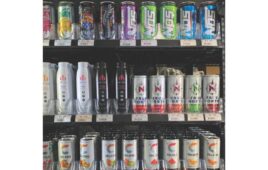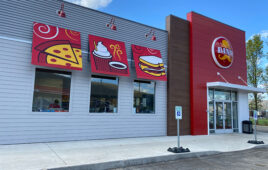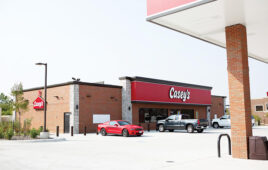Although health & beauty care can be a tough sell in the convenience channel, retailers who appropriately target customers and carry the proper inventory can increase turns and profits.
By Lisa White, Contributing Editor

Believe it or not, there was a time when health and beauty aids were a priority, rather than a necessity, in the convenience channel.
With the focus on prepared foods, fountain drinks and coffee, this is no longer the case.
“When c-stores were first established in the ‘60s, HBC (health & beauty care) was one of the priority sections, with stores typically dedicating between 16-18 feet to these products,” said Dean Cline, founder of Cline Associates, a broker based in Hickory, N.C. “In the ‘80s, the shelving space began shrinking to between eight and 10 feet, but this was just prior to drug stores and supermarkets becoming destinations for HBC items.”
Today, these products are relegated to between four and eight feet of mainly sample sizes of medicine brands and travel sizes of health and beauty care items in this channel.
Rather than putting these products to the wayside, signs point to a missed opportunity for retailers in this segment. Facing fierce competition from drug stores and dollar retailers, c-stores must craft tailored strategies to appeal to and convert potential HBC shoppers.
PRODUCT POTENTIAL
In its nine locations, Grand Forks, N.D.-based Valley Dairy Convenience Stores doesn’t carry a wide array of HBC items, aside from cold medicine, aspirin and shampoo.
“This section doesn’t take up much more than 12 feet of space, and this includes our school supplies, which are under the same umbrella,” said Monica Musich, Valley Dairy’s CEO and president.
Despite this space shrinkage, these products are selling in c-stores.
According to IRI, a Chicago-based market research firm, a number of HBC categories in c-stores showed growth in the 52 weeks ending July 10, 2016. These include gastrointestinal tablets and liquid, cold/allergy/sinus tablets and liquids, cough drops, sanitary napkins/tampons, soap, hair conditioner, deodorant, mouthwash, toothpaste, toothbrush/dental accessories, razors, first aid treatment, suntan products and lip treatment.
“When c-stores started selling sample sizes of aspirin and analgesics, people thought it would hurt their businesses, but it has only helped them and now these items represent a big portion of sales in this channel,” said Cline. “Customers looking for one dose can go to the c-store and pay less than it would cost for an entire bottle.”
Consequently, boxed or sample sizes are on the rise, with a typical c-store carrying between eight and 10 different lines in HBC, Cline said.
The same is true for beauty aids, like toothpaste and hairspray. For those seeking a quick or temporary solution, the spend is less than a full-size item, yet the profit for the retailer is there for the taking. “Both the gondola drug packages and the sample or small box programs of beauty items have helped bring this category back to life,” said Cline.
MEETING CHALLENGES
Because these products are among the highest priced in the convenience channel, theft is a major issue retailers have to contend with.
To deter stealing, Valley Dairy’s HBC section is located close to the register in view of staff.
Flory’s Convenience, Gas & Delis, a convenience store retailer based in Fishkill, N.Y., stocks its HBC items behind the register.
“We used to have these products on the floor, but had a problem with stealing,” said Jerry Flory, co-owner. “Customers have access to it, but we closely monitor this area.”
For Git ‘N Go, a 19-store chain based in Des Moines, Iowa, the health and beauty segment is about 1.2% of sales. Leaders in the category include Goodys/BC powders and energy products.
“This category has a much higher shortage than the overall store,” said William Baine, CEO. “Our overall shortage inside the store is around half a percent in sales, however in the Goodys/BC powders, we were losing up to 20% of purchases.”
As a result, the stores moved several top-selling SKU’s in this category behind the counter.
“We use item level reporting on receiving, audits and sales with our Pinnacle system,” said Baine. “This allowed us to isolate our shortage problem to specific SKUs.”
CATEGORY CAPITALIZATION
One of the big trends occurring in the retail space that can positively impact the c-store HBC category is that of personalization. This can be in the form of relaying the appropriate messages to customers.
“Amazon was the leader of this, but now people are scared as to how this company will grow and eat into share of wallet,” said Drew Breunig, vice president of business applications at PlaceIQ, a New York technology provider.
As a result, this personalization has been webinized so effectively that the playing field is no longer level.
By shortening the distance between consideration and the decision to purchase, brick and mortar stores have the upper hand over online service provider Amazon and others.
“C-stores have an advantage in terms of purchasing and delivery, since the immediate gap between need and purchasing can be more easily met,” said Breunig.
In tracking consumer behaviors to understand how people shop, PlaceIQ has discovered that drug store use is lower in urban areas, since these channels are mainly visited as people are driving home from work.
“The advantage of c-stores as a destination for HBC items is that the locations typically fit into consumers’ lives easier than other channels,” said Breunig.
As a result, c-stores that cater to the appropriate audience typically have an edge in the HBC segment.
“The most important thing for c-stores is personalization, or figuring out how people who shop in the store work, live and commute,” Breunig said. “We’ve found, for a majority of c-stores, the main customers are not those who live nearby, but those who go by on the way to and from work.”
Location can be beneficial for a c-store’s HBC sales. For example, Flory’s is located near a hotel, so it does a big business with toiletry items, including hairspray and shampoo.
“Our HBC sales are strong and have remained consistent, so we haven’t had to run promotions. These products sell themselves here,” Flory said.
Although Saukville, Wis.-based Mad Max Convenience Stores has a limited HBC offering, its 10 stores dedicated space near the counters to merchandise these products.
Like many other c-stores, Mad Max doesn’t promote HBC heavily due to the limited items that it carries.
“It’s hard to run a two-for-one promotion on these items and expect a bump in sales,” said Steve Magestro, Mad Max president. “We have found out that people will not do a promo purchase on multiples because they just need that item once.”
Mad Max’s HBC selection is impacted by name brands and sell-through. “Most people do not think of our channel as a place to get HBC items,” said Magestro. “As this is a small category for us, we spend more time on areas where we are selling through product.”




